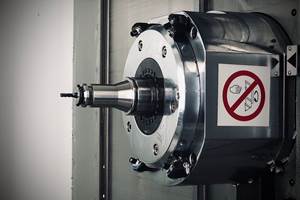Deep Holes with a Carbide Microdrill That Flexes
These microdrills combine the advantages of HSS with those of solid carbide.
Share





The microdrills in the CrazyDrill Flex line from Mikron Tool (Monroe, Connecticut) are designed to combine the advantages of HSS (flexibility and resistance to breakage) with those of solid carbide (precision and resistance to wear). This combination makes the drills reliable in difficult drilling situations yet very productive in holemaking capability. The Flex line covers diameters ranging from 0.1 to 1.2 mm in 0.01-mm increments. Two length categories are available for holes as deep as 20 times diameter or 30 times diameter.
According to the company, the drill’s unusual flexibility is attributable to two factors. For one, the drills are made of a new carbide alloy that is engineered to have mechanical properties that make it less brittle than other carbides and more like HSS in terms of what the company calls elasticity. For another, the geometry of the drill includes an extended neck with a reduced cross section between the shank and the fluted cutter head. As a result of these engineering concepts, the Flex drill is slightly bendable. It can flex from 0.1 to 0.6 mm from center, depending on the overall length of the neck.
Furthermore, the carbide alloy retains the wear resistance and hardness of typical carbides, the company says. This enables the drills to remove material faster than HSS and last longer before dulling. In addition, a 140-degree point angle and wide flutes aid chip breakage and evacuation. Smooth chip flow also reduces cutting forces such as torque and feed force. This geometry is also said to prevent stringy chips from wrapping around the neck or shank.
Having HSS-like flexibility and carbide-like wear resistance makes the Flex drills suitable for situations in which holemaking equipment offers less-than-precise drill positioning. Positioning error can be caused by misalignment in the rotary indexing tables of transfer machines, the spindle drums of a multispindle lathe or drill stations in a series. Thermal expansion on a machining center can also cause misalignment. In any of these cases, the drill’s slight flex can compensate for misalignment, thus preventing excessive side forces from snapping the tool. The resulting reliability of the microdrill and its capacity for high drilling speed makes it useful for lights-out or lightly attended operations, the company says.
According to the company, the performance of these drills makes holemaking operations on these machines competitive with small-hole EDM (electrical discharge machining) and laser drilling. The company reported a test cut involving 10 holes measuring 0.5 mm in diameter and 15 mm deep. The Flex drill took 3 minutes to perform the operation versus 24.4 minutes for gundrilling and 30 minutes for EDM.
However, using this type of microdrill may require a change in CNC holemaking routines. Drills in diameter sizes at the low end must have a pilot hole produced by a CrazyDrill Flex Pilot drill of the same diameter. The pilot hole, which works best at three times the drill diameter, centers the Flex drill and stabilizes as it as it enters. Also, while holes as deep as seven times diameter can be produced in one step, drilling deeper holes (as deep as 30 times diameter) requires additional pecking cycles.
These microdrills have been used successfully to drill deep holes in aluminum, brass, copper and steel. The company reports the main applications to be micromachining of precision parts in the watch and medical industries or for machining fuel injection components.
Related Content
How to Troubleshoot Issues With Tool Life
Diagnosing when a tool is failing is important because it sets an expectation and a benchmark for improvements. Finding out why gives us a clue for how to fix it.
Read MoreQuick-Change Tool Heads Reduce Setup on Swiss-Type Turning Centers
This new quick-change tooling system enables shops to get more production from their Swiss turning centers through reduced tool setup time and matches the performance of a solid tool.
Read MoreShop Reclaims 10,000 Square Feet with Inventory Management System
Intech Athens’ inventory management system, which includes vertical lift modules from Kardex Remstar and tool management software from ZOLLER, has saved the company time, space and money.
Read MoreThe Future of High Feed Milling in Modern Manufacturing
Achieve higher metal removal rates and enhanced predictability with ISCAR’s advanced high-feed milling tools — optimized for today’s competitive global market.
Read MoreRead Next
Machine Shop MBA
Making Chips and 91ÊÓƵÍøÕ¾ÎÛ are teaming up for a new podcast series called Machine Shop MBA—designed to help manufacturers measure their success against the industry’s best. Through the lens of the Top Shops benchmarking program, the series explores the KPIs that set high-performing shops apart, from machine utilization and first-pass yield to employee engagement and revenue per employee.
Read MoreLast Chance! 2025 Top Shops Benchmarking Survey Still Open Through April 30
Don’t miss out! 91ÊÓƵÍøÕ¾ÎÛ's Top Shops Benchmarking Survey is still open — but not for long. This is your last chance to a receive free, customized benchmarking report that includes actionable feedback across several shopfloor and business metrics.
Read MoreAMRs Are Moving Into Manufacturing: Considerations for Implementation
AMRs can provide a flexible, easy-to-use automation platform so long as manufacturers choose a suitable task and prepare their facilities.
Read More






















